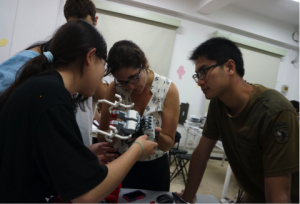by Dan Luo and Gabrielle Vukasin
During this week, students from BNU listened to lectures and participated in activities run by faculty members from BNU, Tufts University and University of Tennessee. They were introduced to various activities related to STEM education. Major topics included: LEGO kits in classrooms, Arduino programming, Novel Engineering and robotic design.
On the first day, Dr. Chiang (BNU) and Dr. Wright (University of Tennessee) gave lectures defining the key concepts of STEM education. They explained techniques of how to help inspire creative thinking in students and how to conduct STEM education in classrooms.
Dr. Wright had the students participate in sample lessons that he conducts in elementary and middle school classrooms to promote engineering thinking. For example, he sent one student outside of the classroom and had that student talk out loud. He then posed the question: how does the sound travel from this student to your ear? He then had students talk in small groups using drawing as a tool to explain their observation and theories. They discussed the properties of sound waves of which they knew and developed a theory together. The groups then shared their theories with accompanying drawings. The capstone of this activity was to come up with a final theory as a class and then have the teacher explain any properties of sound waves that were lacking after the class discussion. This sample lesson showed the student teachers how to inspire their future students to think like an engineer while learning about another STEM subject.
On the second day, Dr. Williams (Tufts University) introduced current trends in STEM education in the United States and the achievements of Tufts University in STEM education via research and outreach to the surrounding community. He emphasized the introduction of engineering education to the United States education system since this is something that education systems in China would like to incorporate.
On the third and fourth days, the graduate students from the CEEO of Tufts University ran workshops to introduce various activities to the students. These activities included squishy circuits, Linux and Lego ev3, Novel Engineering, and Silly Walks.
During the squishy circuits workshop, the student teachers created their own squishy circuits with Play Doh, LEDs, and batteries. Following the activity, the graduate students led a discussion on what concepts this activity can teach younger students and how to emphasize these concepts during the activity.
The Novel Engineering workshop was similarly structured. First, the students read a chapter of Life of Pi and then discussed the issues the main character had, i.e. water, shelter, food, protection from a tiger, etc. They then split into groups and developed solutions to these problems. After presenting these solutions to the rest of the class, the Tufts graduate students led a discussion of how to effectively use this activity in a classroom.
Last but not least, the students were presented with the silly walk challenge: move your LEGO robot without wheels. The students broke into groups and then presented their robots to the class. This was one of the students’ favorite activities as indicated by their engagement. The Tufts graduate students then led a discussion on how to promote creative thinking in students in activities such as silly walks.
To combine all that the students had learned during this week, the students presented lesson plans they came up with in groups. They described the concepts the lessons would teach and what methods and technologies they would use. One group came up with a lesson plan to teach students about sensors. In their lesson plan, they had an activity for students to develop their own games using different sensors. Above is a picture of an NXT pinball machine they created to serve as an example of a game.
On the final day, the Tufts graduate students gave a presentation about engineering education at the CEEO, describing projects at the CEEO such as the STOMP program and Jumbo Makerspace. One of the reasons for this workshop was to inspire the STEM education group at BNU and other similar groups to create programs such as STOMP in their community. From the response of the students and faculty at BNU, this was accomplished.






